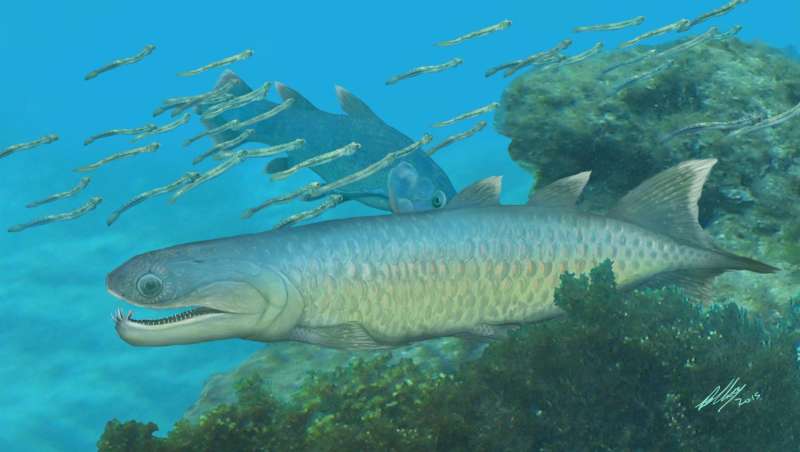June 6, 2016 report
Skull analysis of Qingmenodus offers insight into creatures between pre-lobed fish and tetrapods (Update)

(Phys.org)—A team of researchers working at the Chinese Academy of Sciences has uncovered new characteristics of Qingmenodus, an Onychodont that lived during the time between fish without lobed fins and tetrapods. In their paper published in the journal Science Advances, the team describes their study of the fish and discuss its possible place in the evolutionary history of the creatures that eventually made their way onto land.
Onychodonts lived approximately 400 million years ago, which means their fossil remains are few and far between, and study of those that have been found has not always been very productive. Still, scientists have found evidence of very ancient primitive fish that did not have lobed fins and evidence of less primitive fish with fully formed lobed fins (necessary for the development of fins that could be used to initially walk about on land), but have not had much luck in finding fish samples that represent the time between these other two groups. This has led to lively debates among early life scholars regarding the evolutionary tree regarding all of the various fishes that eventually led to the ones that actually crawled out of the sea to become our true ancestors. Recently, however, a good sample was found, the remains of a 409 million year Qingmenodus—in China—and more importantly, it had a well-ossified skull. To get a good look at it, inside and out, the team used high-resolution tomography to capture images of the internal structures of the braincase, which allowed them to reconstruct the cranial endocast.
The team reports that the brain structure of Qingmenodus was similar in some respects to lungfish (a modern fish that has lungs and lives in mud) and other osteolepiforms (prehistoric lobe-finned fish), it had other clear differences as well—the brain case was elongated and it had well-developed processus connectens, which the researchers suggest was closer in nature to coelacanths (prehistoric large bony fish with fleshy pectoral fins).
The team suggests further study of the Qingmenodus sample, and others that have been found may help piece together the relationship between Onychodonts, other prehistoric fish and more specifically, those that eventually climbed out of the sea and slowly evolved into land dwelling creatures.
More information: J. Lu et al. A Devonian predatory fish provides insights into the early evolution of modern sarcopterygians, Science Advances (2016). DOI: 10.1126/sciadv.1600154
Abstract
Crown or modern sarcopterygians (coelacanths, lungfishes, and tetrapods) differ substantially from stem sarcopterygians, such as Guiyu and Psarolepis, and a lack of transitional fossil taxa limits our understanding of the origin of the crown group. The Onychodontiformes, an enigmatic Devonian predatory fish group, seems to have characteristics of both stem and crown sarcopterygians but is difficult to place because of insufficient anatomical information. We describe the new skull material of Qingmenodus, a Pragian (~409-million-year-old) onychodont from China, using high-resolution computed tomography to image internal structures of the braincase. In addition to its remarkable similarities with stem sarcopterygians in the ethmosphenoid portion, Qingmenodus exhibits coelacanth-like neurocranial features in the otic region. A phylogenetic analysis based on a revised data set unambiguously assigns onychodonts to crown sarcopterygians as stem coelacanths. Qingmenodus thus bridges the morphological gap between stem sarcopterygians and coelacanths and helps to illuminate the early evolution and diversification of crown sarcopterygians.
Journal information: Science Advances
© 2016 Phys.org


















